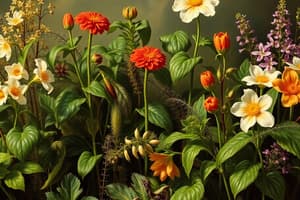Podcast
Questions and Answers
What are the two subclasses of plants based on seed structure?
What are the two subclasses of plants based on seed structure?
Monocots and Dicots
Give an example of a plant belonging to the Monocots group.
Give an example of a plant belonging to the Monocots group.
Grasses, orchids, or lilies
Which group of plants produce seeds with no protective cover?
Which group of plants produce seeds with no protective cover?
Gymnosperms
What type of plants produce spores instead of seeds?
What type of plants produce spores instead of seeds?
How do plants contribute to our daily lives?
How do plants contribute to our daily lives?
Flashcards are hidden until you start studying
Study Notes
Exploring the Diverse World of Plants
From the towering redwoods in the forests to the tiny succulents on our windowsills, plants offer an incredibly diverse range of life forms. Let's delve into the myriad types of plants that enrich our world, making it a more vibrant and environmentally sustainable place to live.
Categorizing Plants
Botanists classify plants into several major groups, based on their characteristics and evolutionary relationships. Here are some of the key types of plants:
- Angiosperms: These plants produce seeds enclosed within an ovary, which develops into a fruit. They are often referred to as flowering plants and make up the greatest percentage of plant life.
- Gymnosperms: Plants in this group produce seeds that are not enclosed within an ovary but are exposed on cones, such as pine or deciduous conifers.
- Pteridophytes: These plants produce spores instead of seeds, such as ferns and mosses.
- Bryophytes: Including liverworts, hornworts, and mosses, these non-vascular plants do not have specialized tissues for transporting water and nutrients.
- Algae: Algae are photosynthetic organisms that do not have specialized tissues or organs. They are primarily aquatic and include single-celled forms as well as large kelp-like structures.
Angiosperms: The Flowering Plants
Angiosperms include many familiar plants such as tomatoes, corn, and sunflowers. They are further classified into two subclasses:
- Monocots: These plants produce seeds surrounded by a single layer of tissue called the seed coat. Monocots include grasses, orchids, and lilies.
- Dicots: Plants in this group produce seeds surrounded by two layers of tissue. Dicots include trees, shrubs, and vegetables such as beans and carrots.
Gymnosperms: The Conifers
Gymnosperms consist of several groups of plants that produce seeds with no protective cover. This group includes conifers such as pine trees, deciduous conifers like ginkgo trees, and cycads.
Pteridophytes: The Ferns and Mosses
Pteridophytes include vascular plants that produce spores instead of seeds. This group includes familiar plants like ferns and mosses. Ferns are large, leafy plants that produce spores on specialized structures called sporangia. Mosses are small, non-vascular plants that grow in damp environments.
The Role of Plants in our Lives
Plants form the foundation of almost all ecosystems on Earth, providing oxygen, food, and shelter for numerous other organisms. They are also the primary source of food for millions of people worldwide. Plants' ability to convert sunlight, air, and water into food through photosynthesis allows them to serve as a source of energy and nutrition for animals, humans, and microorganisms.
Plants contribute to our daily lives in numerous ways, from the food we eat to the materials we use for construction and clothing. Many plants are also used in traditional and modern medicines, offering potential cures and treatments for various illnesses.
As our knowledge of plants grows, so does our appreciation and understanding of the vital role they play in our lives. Exploring the diverse types of plants and their unique characteristics helps us gain a deeper appreciation for the natural world and the importance of conserving its abundance and beauty for generations to come.
Studying That Suits You
Use AI to generate personalized quizzes and flashcards to suit your learning preferences.




